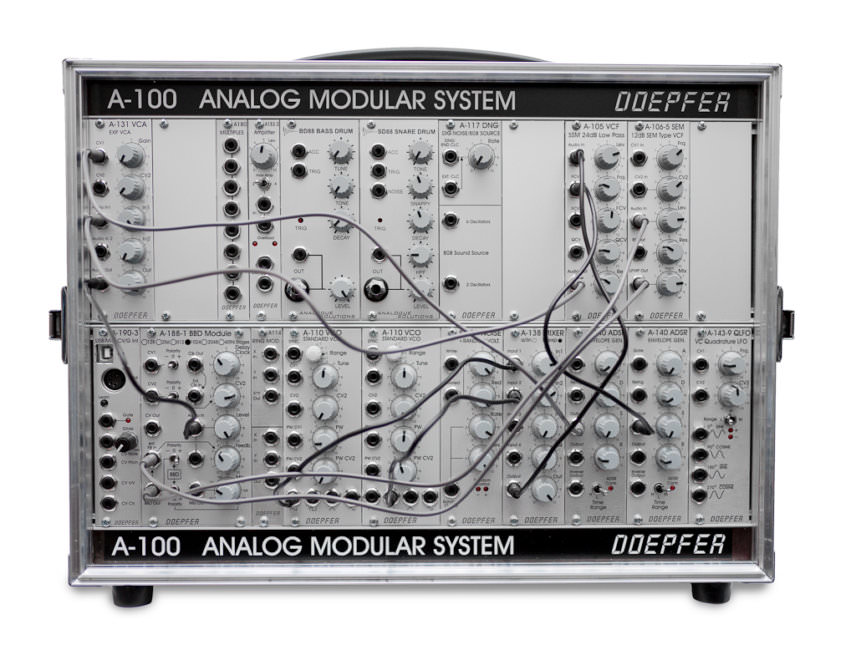Ever felt overwhelmed by patches, cables, beeps and squeaks? Been wondering what the difference is between a VCO and a VCF? In our new monthly series, LeoMakes is going to break it down by starting from the beginning and working towards more advanced modular synthesis techniques. Enjoy and happy patching!
Introduction to Modular Synthesis
If you are beyond the intro and wish to jump straight to part 1, then click here!
If you’re into electronic music production, there’s a good chance that you’ve seen modular synthesizers all around lately. These days, it’s nearly impossible for a music producer to look through social media, YouTube or a music publication without seeing either a wall of modules in a studio or a portable rig on stage exploding with colorful patch cables.
While the concept of modular synthesis has been around since the mid-1960s, such systems have historically remained out of reach for most musicians. This has been due to a variety of reasons including the astronomical price tags, steep learning curves and other practical considerations like the large physical size and temperamental nature of the electronics.

However, all this has been changing over the last decade and the popularity of modular systems has really exploded over the last five years. I don’t think it’s a stretch to say that we’re living through a veritable modular synthesizer renaissance! What’s more is that this is a wonderful virtuous cycle: As these powerful musical tools find their way into more and more recordings, more musicians find themselves owning—or wanting to own—modular systems of their own. This, in turn, encourages manufacturers to push the boundaries and create more interesting and innovative modules. The end result is more sonically diverse music and huge numbers of musicians discovering (or re-discovering) the joy of sound design. As a sound design enthusiast, this is music to my ears!
I don’t think it’s a stretch to say that we’re living through a veritable modular synthesizer renaissance! .
Perhaps you own a modular synthesizer or have been thinking of starting your own modular synthesizer journey? Maybe you have considered buying a system but have been scared away by the high price tag and sheer number of options when it comes to modules? Maybe you have purchased a system and are overwhelmed by the learning curve or intimidated by option anxiety (i.e., “where should I patch this signal next?”) Not to worry, I’m here to help!
The good people at Attack Magazine have asked me to create a series of articles to help readers make sense of the fun, fascinating and sometimes confusing world of modular synthesis. In this series, we’ll start from the very basics and work our way up to more advanced topics and exercises. I will adapt the subject matter depending on feedback that I get from readers, so speak up! Let me know your modular synthesizer questions and queries and I will do my best to cover them in future articles.
While I am a sound design enthusiast, industry veteran and owner of my own Eurorack module company (www.strangesci.com), I still consider myself very much a student of synthesis. I find myself learning new things every day and I certainly don’t consider myself an authority on the subject. In fact, there may be people in the readership that know more about certain areas than I do and I hope these people will chime in and share their knowledge and expertise. In short, I want this series to be a two-way conversation where everyone learns and benefits.
To get started, head over to part 1!
What are your thoughts and questions? Please leave them below or on Facebook and we’ll be sure to address them in future articles.
About the author
Leo from LeoMakes is a proud musical instrument (M.I.) industry lifer. He has spent his entire career working on instruments and helping musicians create the music that they have always dreamed of making. He is happy about this and sleeps well at night.
Throughout his career, he has worked for a number of great companies: inMusic (Alesis/Numark/AKAI Professional), M-Audio, Avid, Propellerhead, XLN Audio. He has held many different job titles ranging from technical writer, senior product manager, sales and marketing guy and now co-founder of Strange Science Instruments (www.strangesci.com).
He continues to consult many companies on their technical, engineering, marketing and design challenges and writes articles for music publications like Attack Magazine. When he is not doing all this, he is busy building interesting (and sometimes insane) musical creations on his YouTube channel.

11.51 AM
I fall squarely in the segment of “always loved the look and sound of modular” but it the price and steep learning curve always scared me away. Plus, I am not a musician but I’ve always loved making ambient and experimental music, so I have various grooveboxes, samplers and Teenage Engineering Pocket Operators. It was TE’s new 400 Modular and Korg’s Modular that made me think about dipping my toe in the modular waters. I downloaded VCV Rack and I have been slowly working my way through YouTube tutorials. So I am super excited to follow your series, especially since you are starting it at the beginning for all of us who are novices looking for a way into the “cool kids club”!. 🙂